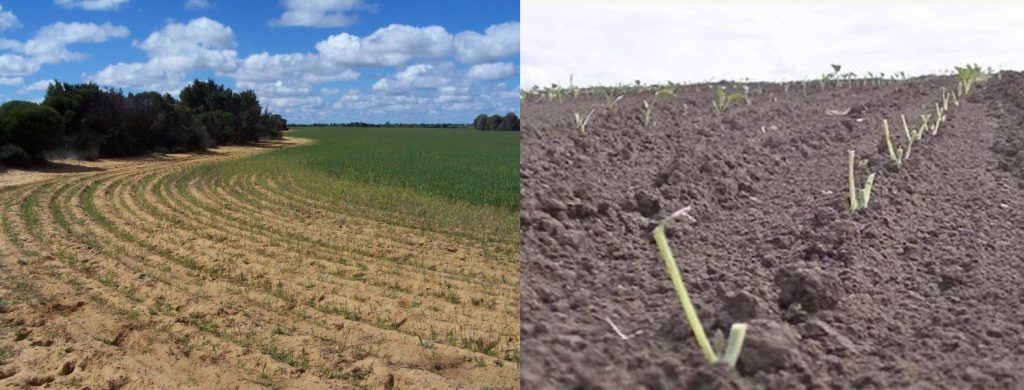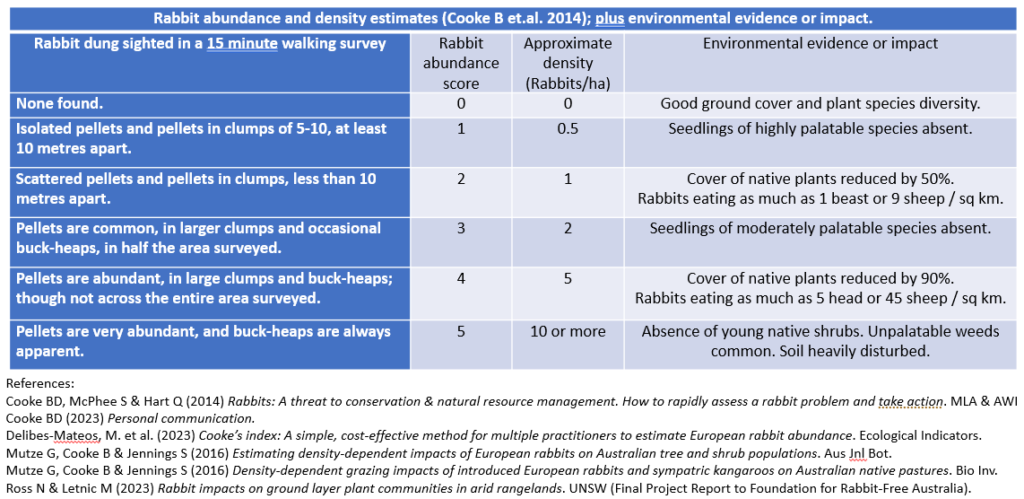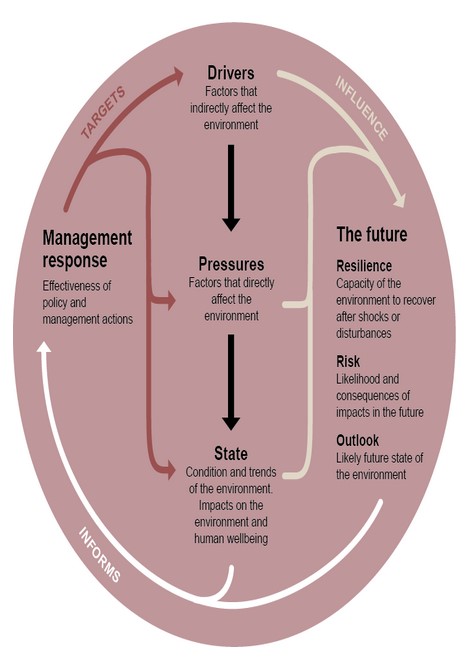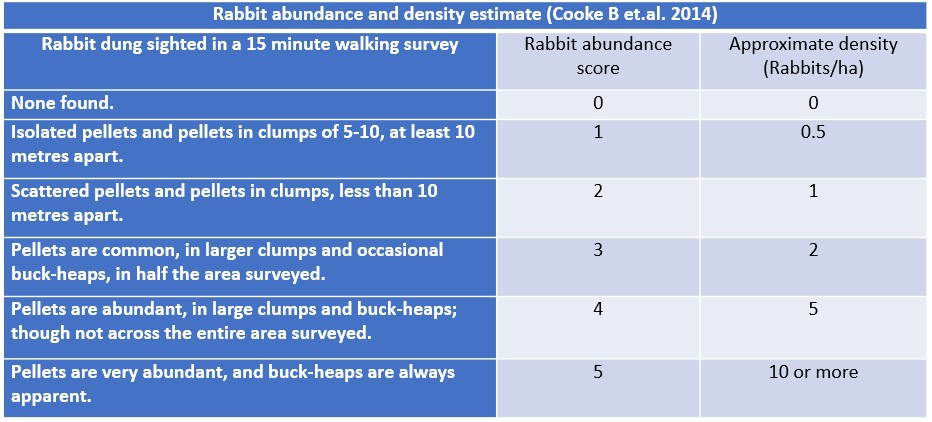In this section: Assessment
Introduction to Assessment
The first step in adaptive pest management is to define the problem and understand as much as possible about the pest. Analysis of rabbit problems is aided by data on:
- Their impact – signs of rabbit damage.
- Their distribution and abundance – where rabbits are found and, especially, where their warrens are. Warrens are crucial to rabbit breeding and therefore a key to their control. Knowing where they feed can help if baiting will be part of the control program.
Problem definition.
Specifying the problem, determining its root cause, and considering what differences (or outcomes) would occur if the problem was removed, is a great way to start planning a control program. It helps give focus and strategy to the plan.
Rabbit damage
Rabbit damage can go unseen by untrained eyes. The most obvious signs of a rabbit problem are often grazing impacts on vegetation or soil erosion and weeds. More subtle signs, such as the absence of native plant seedlings, are harder to detect. Signs of rabbits being present include their distinctive diggings (‘scratchings’) and buck heaps (piles of dung), as well as their warrens and sightings of rabbits themselves.


For more information:

Rabbit density, the number of rabbits present in a certain area, affects the type and severity of damage they are causing.

Causes of rabbit problems
Reflecting on the root cause of a rabbit problem helps in appreciating the breadth of management interventions that could be part of a solution. Root causes could be things like changes in land management (feral cat or fox control), increased cover by harbour-providing weeds, or reduced effort in pest control.

For more information on problem analysis and how to get started:
Measure the problem. Rabbit distribution & abundance
Rabbits are highly social, territorial animals. They are preferential feeders – seeking out plants of high nutritional value from within their home range, which they mark and defend. Their warren is their home base to which they return after feeding. Rabbits rely on warrens for successful breeding, safety and to avoid extremes of weather. Harbour such as debris or thick bush (e.g. blackberries) also provide protection, enabling them to establish burrows and warrens.
Rabbits are prolific breeders and can quickly recover from low numbers in favourable seasons.
Control programs will be of little long-term value if not done properly or not followed up.
Their close social bonds leave rabbits vulnerable to transmissible diseases and their reliance on warrens leaves them vulnerable and unlikely to breed if that harbour is destroyed. Effective rabbit control requires a good appreciation of where they are breeding or sheltering and, especially if baiting, their preferred grazing grounds.
See Rabbit Biology for more information on rabbit behaviour and breeding requirements.
There are numerous guides available describing survey and data collection techniques, covering rabbit abundance and distribution (e.g. warren counts, dung counts and spotlight counts) and rabbit impacts (e.g. vegetation, native animals, crop yields, stock returns, and soil erosion). They are summarised below and examples are provided under Useful resources.
Mapping warrens
Warren destruction is often the key to an effective rabbit control program. Mapping warren distribution provides a good focus and permits planning of field work, schedules and budgets for control programs. It also provides an opportunity to estimate rabbit abundance, either by:
- Counting warrens – either in total or along transects to assess warren density per unit area, or
- Counting active entrances – which are highly correlated with rabbit numbers; commonly around 1.6 entrances per adult rabbit in non-breeding seasons (the best times for rabbit control).
For information on handy tools:
Assessing rabbit abundance
The distribution and abundance of rabbits can be assessed by:
- counting rabbits (spotlight or daylight sightings),
- counting rabbit dung,
- counting and/or mapping warrens,
- recording rabbit tracks or footprint counts,
- surveying rabbit impacts or
- live trapping (for capture-recapture surveys)
- camera traps (trail surveillance cameras).
The presence and abundance of other animals (e.g. foxes, cats and kangaroos) can also be recorded during rabbit surveys. Camera traps set to monitor warrens or footprint surveys can also determine if animals other than rabbits are using the burrows (e.g. goannas, bandicoots, foxes or feral cats).
Monitoring and recording
Information gained about rabbit distribution and abundance will help target rabbit control projects and provide a benchmark against which control efforts may be assessed. Survey and data collection guides are available from PestSmart website covering warren counts, dung counts and spotlight counts, as well as for rabbit impacts (e.g. vegetation, native animals, crop yields, stock returns, and soil erosion) and the use of camera traps.
Several survey and monitoring guides are listed below. ‘Monitoring techniques for vertebrate pests. Rabbits’ is a comprehensive guide to many of the assessment options listed above.
RabbitScan is a handy tool for record keeping and an aid in planning. Other options that local groups can use for record keeping and analysis include Fulcrum and Landcarer Community which offers opportunities to share information, insights and resources with others and to record data on your rabbit control activities.
Useful resources:
References & Weblinks
pestSMART website
- About European rabbits – introducing rabbits
- Define your rabbit problem and assess impacts – concept introduction
- Glovebox Guide for managing rabbits ‘how to’ guide for all stages of planning and control
- Map and monitor with RabbitScan – introducing an app for record keeping, and so much more
- Pest animal monitoring techniques – ‘how to’ videos
- Handy resources – PestSmart – collated resources for planning and monitoring rabbit control.
Governments in every State provide rabbit control information for land managers:
- Ag Vic – Integrated rabbit control
- Business Qld – Rabbit
- NSW Department of Primary Industries – Rabbit control & LLS – Rabbits
- NT Government – Feral rabbit
- SA Primary Industries and Regions – Wild rabbits
- Tas Natural Resources and Environment – European rabbits
- WA Primary Industries and Regional Development – Rabbit control options
References
- Campbell S & Pacioni C. (2014) ‘Maximising the potential of improved biological control for rabbits.’ Department of Agriculture and Food (WA) for ABARES
- Cox T, Matthews R, Halverson G & Morris S. (2021) ‘Hot stuff in the bushes: Thermal imagers and the detection of burrows in vegetated sites.’ Ecology & Evolution. 11:6406-6414
- Delibes-Mateos M, Castro F, Arias de Reyna L, Camacho A, Cooke B & Villafuerte R. (2023) ‘Cooke’s Index: A simple, cost-effective method for multiple practitioners to estimate European rabbit abundance’. Ecological Indicators, Vol 150.
Downloads
Comprehensive guides
- ‘Glovebox Guide for managing rabbits.’ (2020) Brown A, Cox T & Wishart JH. Centre for Invasive Species Solutions.
- ‘Managing Vertebrate Pests: Rabbits.’ (1995) Williams K, Parer I, Coman B, Burley J & Braysher M. Bureau of Resource Sciences & CSIRO Division of Wildlife & Ecology ResearchGate download
- ‘Rabbit Control. A guide for land managers’. (2008) Hunter C et.al. Dept of Primary Industries & Fisheries, Qld.
- Darling Downs-Moreton Rabbit Board guides
- Damage caused by rabbits
- Signs of rabbit presence – What to look for
- Property inspection – Where to look
- Basic Guide to Rabbit Control – Best options for different situations
Survey and assessment guides
- ‘Monitoring techniques for vertebrate pests. Rabbits.’ (2007) Mitchell B & Balogh S. NSW DPI, Orange & BRS (For more information, see below)
- RHDV Identification Fact Sheet (Iannella, 2023) A field guide to determine if RHDV is present.
- ‘Rabbits and Native Plant Biodiversity’ (2007) Cooke BD & McPhee S. AWI, MLA & Invasive Animals Co-operative Research Centre
- ‘Rabbits: A threat to conservation & natural resource management. How to rapidly assess a rabbit problem and take action’. (2014) Cooke BD, McPhee S & Hart Q. MLA & AWI
- ‘The rabbit and its control. Fact Sheet.’ (2008) Biosecurity Queensland.


